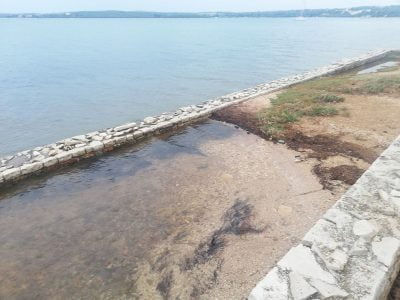In the north of Croatia, on the Vizula peninsula, there are remains of an exclusive Roman villa that was built in the 1st century CE and was inhabited until the 6th century CE. The building has been rebuilt many times over the centuries.
It was an impressive structure, with many seaside terraces, extensive air and water heating system (hypocaustum), cisterns (5 in total), a peristyle, baths and a sewage system. Many of the rooms’ floors were decorated with multi-coloured mosaics with geometric elements. In total, scientists enumerated 18 rooms with swimming pools, an exercise room and places for feasts. The latest aerial photos proved that there was a private port on the western shore of the peninsula, from which residents could go on a sea trip.
In the southeastern part of the peninsula, there was a larger port that had commercial functions. It was 30 meters long and 6 meters wide. Probably the owners of the villas from this place transported local wine, olive oil and olives, which were grown in this part of the peninsula with the help of numerous slaves in villa rustica. Merchant ships with goods from other parts of the Empire also landed here. The discovered remains of commercial vessels ( dolium ) are evidence of the intense trade.
The villa was probably distinguished by wonderful gardens. Cultivated: rosemary, laurel, myrtle, rose, aromatic herbs, olive tree, grape, thyme, calendula, oregano, lavender, pomegranate, almond tree. The villa on the peninsula was connected to the mainland by a road, next to which there must have been an aqueduct supplying fresh water.
Excavation work on the peninsula began in the 19th century. With subsequent discoveries of the walls and mosaics, it was possible to establish that the peninsula was occupied in ancient times by an exceptionally luxurious villa. It covered an area of 4,000 square meters with 4 pools and was probably the residence of the aristocracy, or even the emperor Crispus himself (approx. 300-326 CE). The thesis about the residence of this villa by his son Constantine I, who was later murdered by his father, was put forward by Bernardo Schiavuzzi in 1907. It is suspected that the young heir to the throne fled to the peninsula after accusing him of the rape of Fausta – his stepmother and wife of Constantine I, and of conspiracy. According to Ammianus Marcellinus, Crispus was trialled at Pula in 326 CE; There were also rumours that the young Caesar might have been killed precisely on the Vizula peninsula. The history of Kryspus is so tragic and distinctive for the history of this place that in the summer there are theatre performances in the archaeological park that tell the tragic fate of Kryspus.
The remains of the villa are located in the beautiful archaeological park of Vizula (covering 26 ha), which is well-kept, full of greenery, information signs and seating. A 2.3 km long promenade leads through the park, which was once used by residents and guests of the villa. Additionally, at the entrance to the park, it is possible to use the virtual reality park animal service.
In the nearby Burle, researchers found traces of an ancient necropolis, where numerous graves had beautiful jewellery or glass vessels.
- Roman villa in Croatia
- Roman villa in Croatia
- Roman villa in Croatia
- Roman villa in Croatia











